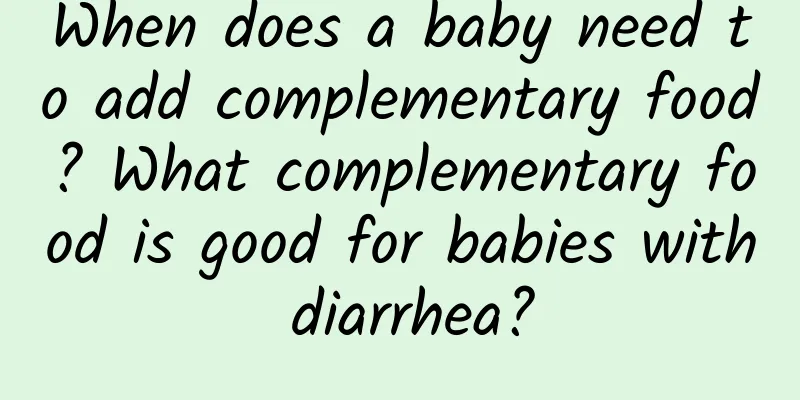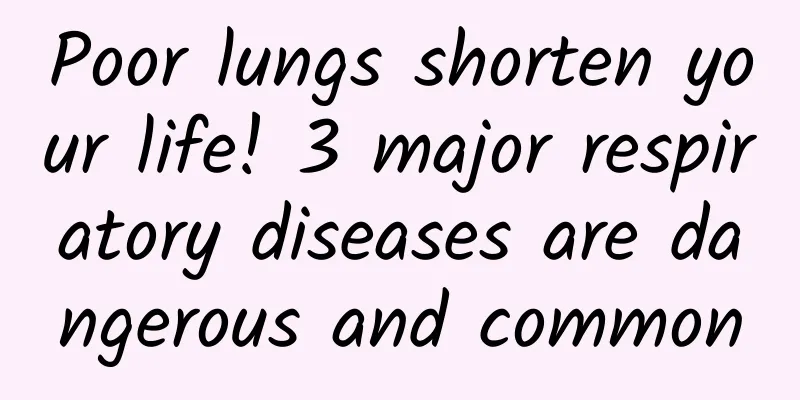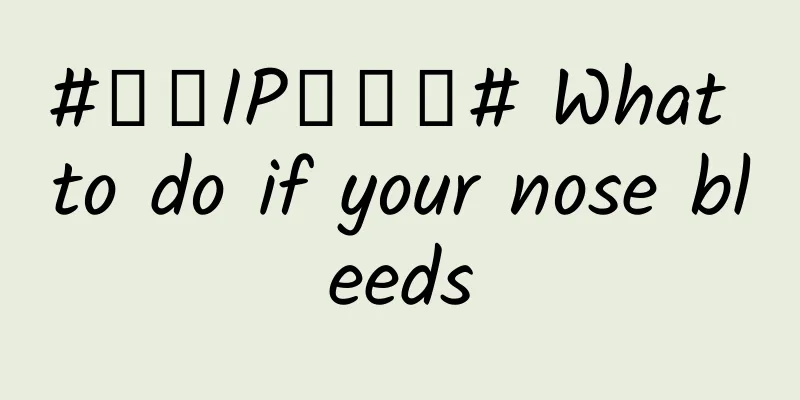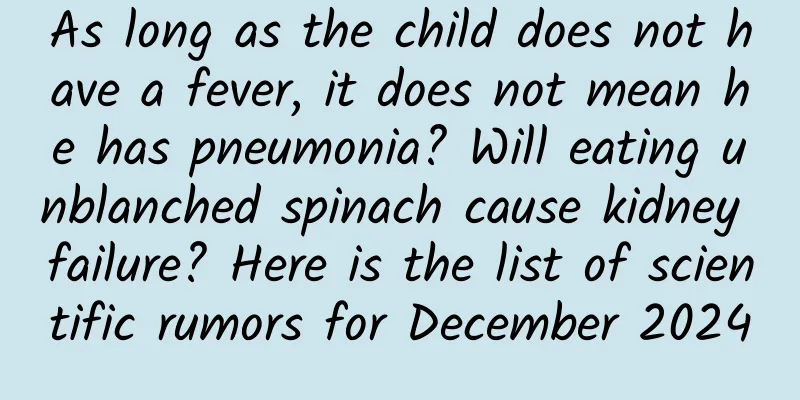When does a baby need to add complementary food? What complementary food is good for babies with diarrhea?

|
Babies are naturally cute and cuddly, and every mother will become warmer and happier because of their babies. Now everyone is raising babies scientifically and carefully. They are all first-time parents and generally don’t know when babies need to add complementary foods, so they need to make a strategy in advance! Contents of this article 1. Under what circumstances does the baby need to add complementary food? 2. What complementary food is good for babies with diarrhea? 3. Can babies eat complementary foods if they have diarrhea? 1When does the baby need to add complementary food?Parents can use the following points to determine whether to start adding complementary foods: Weight: The baby's weight needs to be twice that at birth, at least 6 kg. Not full: For example, the baby used to sleep through the night, but now often cries in the middle of the night, or sleeps for shorter and shorter periods of time; the number of breastfeeding times per day increases to 8-10 times or the baby is fed 1000 ml of formula milk, but the baby is still hungry, crying and wanting to eat. When the baby has a growth acceleration period around 6 months, it is the best time to start adding complementary foods. Development: The baby can control the head and upper body, can sit with support or leaning against something, can straighten the chest and hold the head upright. The baby can indicate whether he wants to eat or not by turning the head, leaning forward or backward, etc., so force-feeding will not occur. Behavior: If someone is eating next to the baby, the baby will be interested and may grab the spoon or chopsticks. If the baby puts his hands or toys in his mouth, it means that the baby is interested in eating. Tongue sticking reflex: Many parents find that when they first feed their babies solid food, their babies often spit out what they have just put into their mouths, and they think that the baby does not like to eat. In fact, the baby's tongue sticking out behavior is an instinctive self-protection, called "tongue sticking out reflex", which means that it is not yet time to feed solid food. The tongue sticking out reflex usually disappears around 4 months old. If you insist on feeding solid food before it disappears, and blindly force it in, it will not only make parents feel frustrated, but also make the baby feel unhappy, which is not conducive to the cultivation of good eating habits. Eating: If the baby tries to lick and swallow the food when the parents scoop it into the baby's mouth, and the baby smiles and looks very happy and likes to eat, it means that the baby is interested in eating, and you can feed the baby with confidence. If the baby spits out the food, turns his head away or pushes away the parents' hands, it means that the baby does not want to eat. Parents must not force it, and try again after a few days. 2What complementary food is good for babies with diarrheaEgg yolk diet: Boil the eggs, remove the shells and egg whites, and simmer the egg yolks in a pot over low heat to extract oil. Babies under one year old can take one egg yolk oil a day, divided into 2-3 doses, for a course of 3 days. It can treat diarrhea and has the effect of tonifying the spleen and stomach and stopping diarrhea. Egg pancakes steamed with egg yolk, a little flour and shredded ginger have the same effect. Apple diet: Apple contains tannic acid, which has antidiarrheal effect. Wash an apple, steam it, eat the flesh or peel it and mash it into puree for consumption, 30-60 grams each time, 3 times a day. Apple soup is also an auxiliary drink for treating diarrhea. Chop the apple, add 250 ml of water and a small amount of salt, and you can also add 5% sugar, boil it and drink it instead of tea, suitable for infants under 1 year old. Chestnut paste meal: Use 3 to 5 chestnuts, peel and mash them, add water and cook into a paste, add sugar to season and eat 2 to 3 times a day. It has the effect of warming the middle and stopping diarrhea. In addition, orange and jujube tea and carrot soup can strengthen the spleen and stop diarrhea. The diets available during the recovery period include white rice porridge, noodles, lotus root starch, eggs, steamed fish, salty egg custard, etc. Scorched rice soup: First grind rice flour or milk cake into powder, fry until it turns yellow, then add appropriate amount of water and sugar, and then fry it into a paste. After adding water to the rice flour and heating it, it becomes dextrin. Dextrin is easy to digest, and its carbonized structure has a good adsorption and antidiarrheal effect. Carrot soup: Carrots are alkaline foods. The pectin they contain can promote stool formation and absorb bacteria and toxins on the intestinal mucosa. It is a good antidiarrheal food. The preparation method is to wash the carrots, cut them in half, remove the stems, and then cut them into small pieces and boil them with water. Then filter out the residue with gauze, and finally add water (500 grams of carrots to 1000 grams of water) and sugar and boil them. 3Can babies eat complementary foods if they have diarrhea?Baby diarrhea is a clinical syndrome caused by different causes. It mainly occurs in infants under 1 year old. Newborns usually have up to 10 bowel movements a day, and when they are older, it may vary from several times a day to once or twice a week. First, understand the baby's normal bowel habits to determine whether it is diarrhea at the first time. In addition to observing the shape of the stool, you should also pay attention to the smell of the stool. The frequency of bowel movements is more than usual, the texture of the stool is thinner than usual, and even watery stools may appear, and it may be like spraying out of the buttocks. These may be the symptoms of diarrhea in infants, usually accompanied by symptoms of gastrointestinal discomfort such as loss of appetite and abdominal distension. If a child is currently adding complementary food, stop feeding complementary food or reduce the frequency and amount of complementary food. Children should stop feeding foods that are high in oil and meat. If a baby has breast milk, he should try to eat breast milk. For children with nausea and vomiting, in addition to easily digestible food, they should be fed with water and food in small amounts and multiple times, slowly. When diarrhea and vomiting are particularly severe, you can feed less food 1 to 2 times. Long-term fasting is not recommended now because it is not good for children. |
<<: Self-test with one picture: Do you have an eye disease that causes blindness?
>>: Why do babies add complementary foods? How to make complementary foods for babies
Recommend
Why is my vagina dry?
The vagina is the main reproductive organ of wome...
"People's hope" has not yet come true: Remdesivir still needs to be verified
The results of remdesivir in treating COVID-19 ar...
Urinary tract infections in women always recur
Urinary tract infection is very easy to recur. In...
Where is the implantation pain?
Pregnancy is the thing that every woman looks for...
What should I do if my menstruation has not come?
Many female friends have encountered this problem...
16 weeks pregnant lower abdomen needle feeling
Abdominal pain is also common during pregnancy, w...
Why do women urinate with blood?
People often have blood in their urine. In fact, ...
Whose account will the Hangzhou epidemic rental subsidy be paid into? When will the application for the Hangzhou epidemic rental subsidy end?
Considering the impact of the epidemic on local e...
How to make the dough of the pie soft? How to make red bean paste pie?
Pies are fragrant and tender, and are one of my f...
Can I see the fetal heartbeat at six weeks?
For the fetus, the growth of the fetal heart and ...
If you have gallstones and experience right upper abdominal pain after eating greasy food, be careful of acute cholecystitis!
Author: Guo Shubin, Chief Physician, Beijing Chao...
What to do if you have hemorrhoids during menstruation
There are many situations that female friends may...
What is the cause of the egg white discharge?
We all know that it is normal for leucorrhea to b...
What are the symptoms of breast ulcer?
When the breasts are unblocked, milk will flow ou...
What should I do if my Bluetooth headset cannot be paired? Why can't my Bluetooth headset be charged?
Bluetooth headsets have become very popular in ou...









